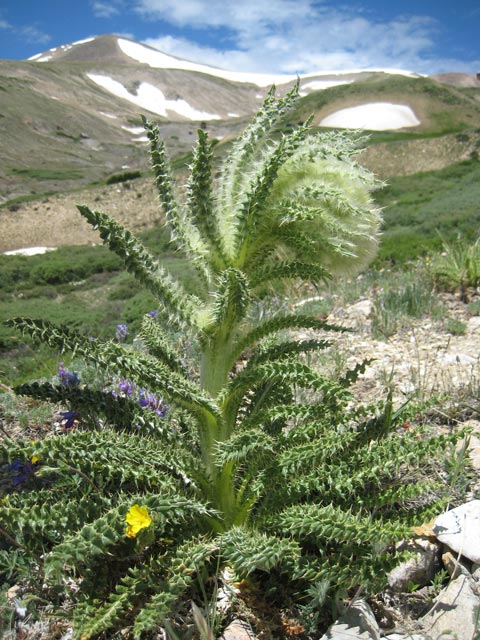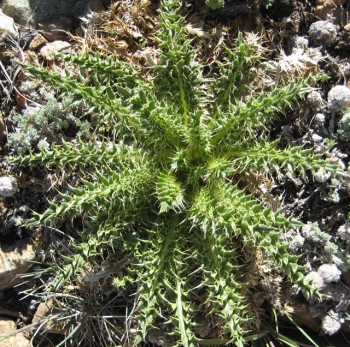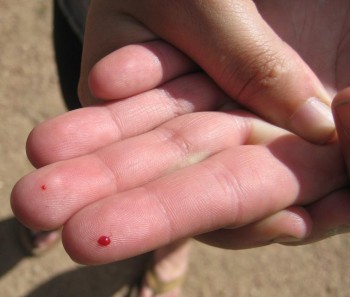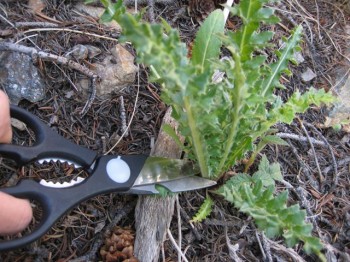
Thistles are a great trail snack. If you’re thirsty, just start chewing on one. After you prick yourself in the mouth, it’ll hurt so much you’ll forget all about being thirsty.
Just kidding, of course. When enjoying thistles as a trail snack, the first thing you need to do is select one that’s not so extraordinarily spiny. The thistle pictured at right, for example, might be a poor choice. Once you have a good one, what you want to do next is to peel the thistle so it’s not spiny anymore. Then, consume.
Kinds of Thistles
The common name thistle refers to several genera of plants:
- Cirsium: So-called “true thistles” belong to the genus Cirsium. In Best-Tasting Wild Plants of Colorado & the Rocky Mountains, Cattail Bob’s thistle entry pertains to any and all species of Cirsium, which he describes as having “spine-tipped leaves… rosettes the first year; flowering stalks after the first year. Flowers are round, spiny, and red, pink, or white.” In The Foragers Harvest (2006), Samuel Thayer has a detailed section on Cirsium + Carduus nutans, including information on regional variations, of which there are dozens of species in the U.S. and Canada, both native and introduced, and varying in palatability.
- Carduus nutans: Nodding thistle, included with Cirsium in Thayer’s account of how to prepare and eat thistle parts. (Don’t be confused by the first picture in this post. That thistle may be nodding, but I don’t think it’s a “nodding thistle”).
- Sonchus species: These are the sow thistles with toothed leaves and copius white milky sap, according to Steve Brill and Evelyn Dean in Identifying and Harvesting Edible & Medicinal Plants (1994), which they admit to eating not for the outstanding flavor but because “it greatly impresses any audience.”
- Silybum species (Is that pronounced silly-bum?) including marianum (milk thistle), which, according to Gregory Tilford in Edible & Medicinal Plants of the West (1997), can be prepared or consumed in a similar fashion as Carduus or Cirsium.

So there you have my best effort in the time alotted for a compilation of the different kinds of thistles there are, keeping in mind that this is by no means a definitive account. I found it a little confusing that different authors chose to focus on different genera or combinations of genera, but my resulting impression was that I could pretty much eat the stalks and leaf mid-ribs of any prickly thistle-looking plant, provided it was not overly spiny.
A quick search revealed that there are no poisonous look-alikes (Seebeck, 1998; Brill & Dean, 1994), but Brill and Dean warn that thistles can absorb nitrates in contaminated soil and make you sick, and Tilford says thistles contain “potentially carcinogenic alkaloids” and should not be consumed in large quantities. No matter. I’d be hard-pressed to consume thistles in an substantial quantities at this point.

Early Trials
Last year I read that the young thistle stalks are good, with a taste and texture reminiscient of celery. I worried about the spines at first, but after reading several accounts of thistle-eating and failing to bring gloves with me on several occasions, I finally tried one, despite the fact that I had not positively identified what kind of thistle it was. I used Gregg’s knife to slice through a plant’s young stalk, placing my bare hands carefully so as not to prick myself. The cutting was the trickiest part. Next I used the knife to strip off the spines, which came off in long strips with the stalk’s fibers. Then I ran my hand along the stalk to make sure I had removed all the spines–and started gnawing on it.
Thayer says to strip off all of the tough outer layer of the stalk, eating only its hollow, juicy innards–and maybe that’s what I did wrong, because I only took off a thin layer and found the stalk to be really chewy. Nonetheless, I appreciated my thistle snack stick as something moist and mild to chew on.
Another time I forgot my water bottle on a hike around the neighborhood. By the time I was on the final stretch I was so parched I had no choice but to locate a rosette of thistle leaves and manually clean off spines and leaf material, leaving only the fleshy midribs. The midribs were much less chewy than the bigger stalk. I must have eaten five of them by the time I got home.
Current Practice

My current thistle-eating practice is to look for big, clean, juicy-looking midribs on healthy leaves, cutting them really low in order to get the fleshiest part and to give myself a relatively spine-free handhold while I’m removing the rest of the prickers. Scissors are nice because after the first cut, if you aim the next one along the length of the midrib from the cut point, you can slice the spines off neatly on each side of the midrib and halfway up into the leaf before trimming off the rest.
The leaves are supposedly edible too, but I had a hard time getting rid of the prickers while leaving parts of the leaf still connected to the midrib. The leaf curled in such a way as to evade my scissors and leave the spiny pieces still connected. So I gave up on that pretty quickly and went back to cutting it close to the stalk.
Backyard Thistle
Just to make sure I described this correctly, I went into the back yard and applied my techniques to one of our thistles. A minute or two per snack stick and voila–I had two thistle leaf midribs like stalks of celery, one for me and one for Gregg. His responses ranged from, “Oh, is this our thistle from near the sculpture?” (Yes) to “This tastes great,” followed by: “I’m not going to eat the rest of this.” There is a chance I waited too long to harvest the backyard thistle, because the midrib was stringy and tough at the bottom. I still ate the whole thing, however.
I wonder if thistle stalks and midribs would make good toothbrushes on account of their fibers and the the fact that they taste so healthy. A little something to clean the teeth after a hike on the trail, perhaps? If so, it would only add merit to the value of thistles as a trail snack.

Leave a Reply